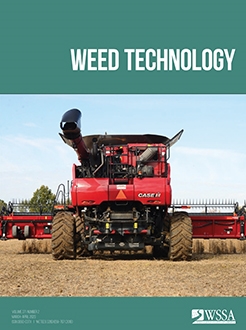A dose-response trial was conducted in two experimental runs at the Purdue University Horticulture Greenhouses, West Lafayette, IN, in 2021/2022 to determine the effect of mesotrione rate on simulated dormant ‘Redefined Murray Mitcham’ peppermint. Peppermint was established in 20-cm-diam polyethylene pots, it was then harvested, and pots were placed in a cooler (4 C) for 1 mo. Potted peppermint plants were removed from cold storage and treated with one of five mesotrione rates: 0 (nontreated control), 53, 105, 210, or 420 g ai ha–1. As mesotrione rate increased from 53 to 420 g ai ha–1, predicted peppermint injury increased from 35% to 80% at 2 wk after treatment (WAT), 36% to 95% at 4 WAT, 9% to 82% at 6 WAT, and 8% to 90% at 8 WAT; and peppermint height decreased from 74% to 42% of the nontreated control (7 cm) 2 WAT, 74% to 17% of the nontreated control (20 cm) 4 WAT, 81% to 15% of the nontreated control (28 cm) 6 WAT, and 88% to 19% of the nontreated control (37 cm) 8 WAT. Mesotrione rates from 53 to 420 g ai ha–1 reduced peppermint dry weight from 40% to 99%, respectively. Results from this experiment showed that mesotrione applied even at half of the recommended field use rate for corn (53 g ai ha–1) was not safe for peppermint due to a reduction in aboveground biomass.
Nomenclature: Mesotrione; peppermint, Mentha × piperita L. (pro sp.) aquatica × spicata ‘Redefined Murray Mitcham'






